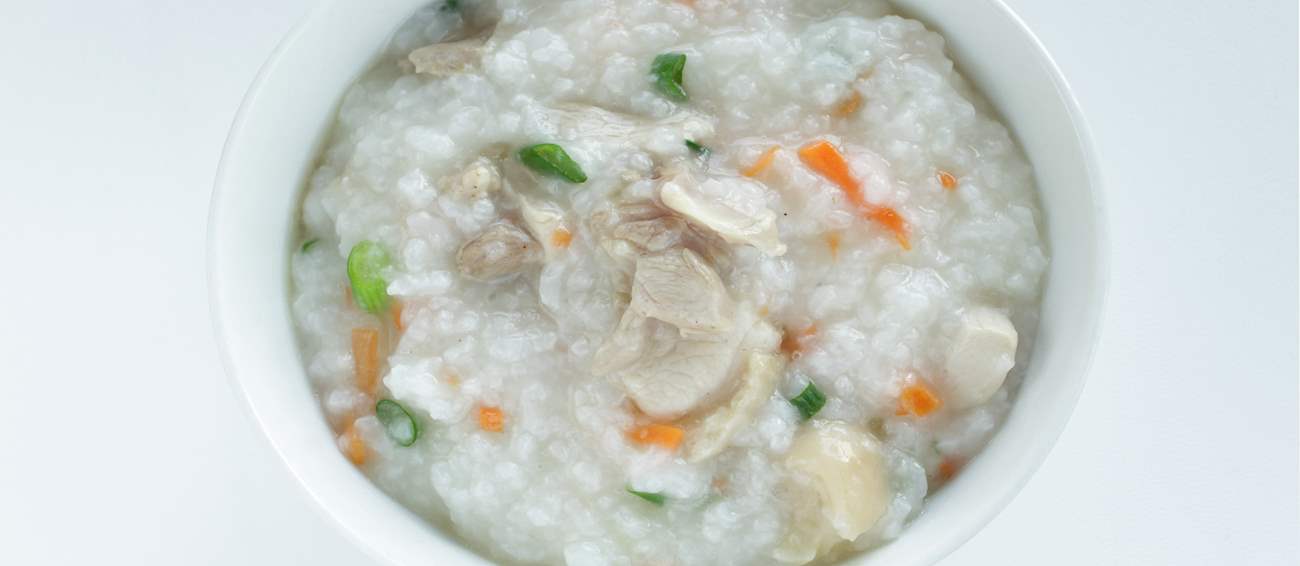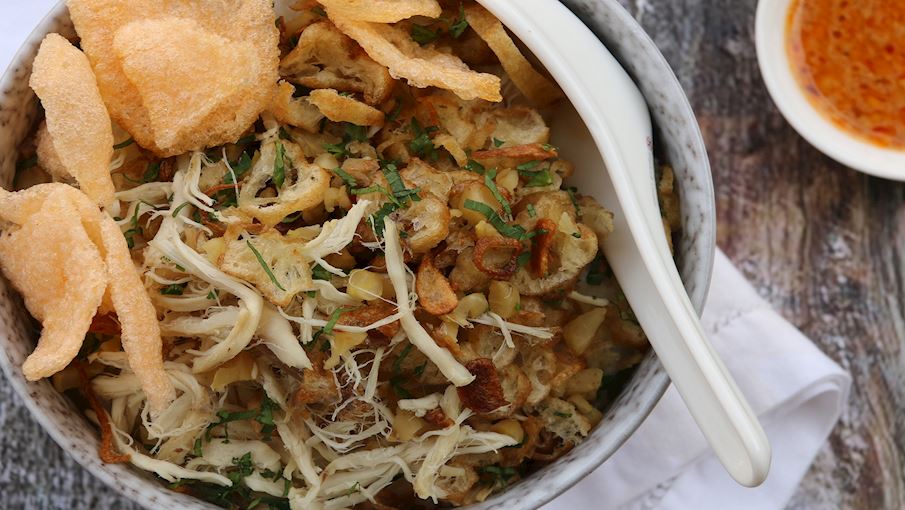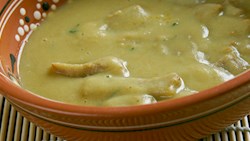Bubur ayam is the Indonesian version of chicken congee, a thick rice porridge topped with shredded chicken and various savory condiments. This breakfast staple probably originates from the Chinese rice porridge, but it employs regionally available ingredients and toppings to create an authentic Indonesian dish.
The process starts with boiling chicken (usually darker, on the bone pieces), and the same broth is typically used to cook the rice until it becomes dense in consistency. Besides rice porridge and shredded chicken, bubur ayam can employ a myriad of other ingredients.
MOST ICONIC Bubur ayam
View moreMAIN INGREDIENTS
Arroz caldo is the Filipino variety of congee, a thick rice porridge that is ubiquitous in many Asian countries. It is also one of many congee varieties found in the Philippines. Distinguished by the addition of chicken, arroz caldo is usually cooked in a ginger-infused broth and served with various accompaniments and seasonings.
Although congee is originally Chinese, this particular variety is believed to have been developed and adapted to suit the tastes of the large Spanish community that was present in the country during colonial times. This comforting rice dish is usually enjoyed as a filling breakfast or a satisfying midday meal.
MOST ICONIC Arroz caldo
View moreMAIN INGREDIENTS
Elarji is a specialty of the Georgian Samegrelo region, prepared as a thick porridge consisting of coarse cornmeal, cornflour, and sulguni or tchkhinti cheese, depending on what's available. The dish has an extremely thick texture, and it is very elastic.
If properly made, one should be able to stretch it overhead. It is traditionally served hot and consumed with Georgian bazhe sauce, made with garlic, walnuts, and various spices.
Taci şi înghite is an interesting variation on the traditional Romanian polenta dish, which is a staple throughout the country. This variation consists of soft mămăligă combined with a mixture of salty cheese and sour cream in alternating layers.
Hearty and filling, the dish is usually topped with grated cheese and eggs, and then baked in the oven. Although the original, layered cheese polenta includes only polenta, cheese, butter, and eggs, it is often prepared with the addition of fried meat, such as bacon and sausages.
Traditionally prepared over an open fire, this velvety Ukrainian corn porridge originated in the Carpathian highlands. It consists of corn flour cooked in a mixture of sour cream and Bryndza cheese. In the past, it was associated exclusively with the Hutsul minority, where the task of preparing the dish was reserved for men.
Today, the dish is an indispensable part of traditional Ukrainian cuisine and it is commonly consumed throughout the country. Found on menus of most traditional restaurants, it usually comes served with fried bacon bits, crumbled Bryndza, mushroom sauce, or crispy cracklings.
MAIN INGREDIENTS
Traditional Romanian-style cornmeal porridge called mămăligă is combined with white cheese in this simple Romanian dish. To make mămăligă, a mixture of cornmeal, salt, and water is gradually poured into boiling water and cooked until it has obtained a thick and smooth texture.
Once prepared, the cornmeal porridge is typically served with different types of Romanian soft white cheeses such as telemea or brânză de burduf. Generous amounts of grated cheese can go either on top of or on the side of the steaming hot porridge, although the porridge is also frequently mixed with the cheese or even layered with it before being baked.
What started as a simple fisherman's dish made with shrimp cooked in bacon grease, then served over creamy grits is today a cult Southern dish due to the fact that Craig Claiborne mentioned it in the New York Times in 1985, after he tried the dish at Crook's Corner, a restaurant in North Carolina.
That version of shrimp and grits was made by a chef called Bill Neal, who also added mushrooms, bacon, and cheddar cheese into the dish. Today, there are numerous variations of the dish found throughout the South, with added hot spices, barbecue sauces, tomatoes, and fried eggs.
MOST ICONIC Shrimp and grits
View moreMAIN INGREDIENTS
Pirão is the quintessential Brazilian side dish which resembles a watered-down porridge or polenta. It appears in numerous varieties throughout the country, but it is mainly prepared by stirring manioc flour in various flavorful meat or seafood broths.
This simple, yet hearty dish has been a staple of Brazilian cuisine for centuries, and even though its exact origins are unknown, it probably originated among the indigenous Brazilian cultures. It is mainly served as an accompaniment to rice and numerous meat and seafood dishes.
Lugaw is a Filipino rice porridge that is traditionally thought of as soft food for sick people, due to the fact that it doesn't require much chewing. Warm, filling, and mushy, the dish acts as an ideal base for any type of meat and seasonings, just like a congee.
Lugaw is usually consumed for breakfast or as a snack. Many cooks like to add chicken, lemon, and ginger in order to improve the flavors of the dish. After that, it can be flavored with typical Filipino ingredients: scallions, garlic chips, sliced hard-boiled eggs, calamansi, or fish sauce.
MAIN INGREDIENTS
Bissara is a comforting Egyptian and Moroccan dish made with puréed beans – either split peas or dried fava beans. It can be prepared in the form of a soup or porridge, while the thicker versions are commonly used as a dip. The puréed beans are typically seasoned with olive oil, lemon juice, and garlic, and the dish is often served with paprika and cumin on the side, while crusty bread is almost mandatory.
Bissara is traditionally served for breakfast, and it is especially popular during winter.
TasteAtlas food rankings are based on the ratings of the TasteAtlas audience, with a series of mechanisms that recognize real users and that ignore bot, nationalist or local patriotic ratings, and give additional value to the ratings of users that the system recognizes as knowledgeable. For the “Top 100 Porridges in the World” list until April 15, 2025, 3,214 ratings were recorded, of which 1,944 were recognized by the system as legitimate. TasteAtlas Rankings should not be seen as the final global conclusion about food. Their purpose is to promote excellent local foods, instill pride in traditional dishes, and arouse curiosity about dishes you haven’t tried.




























































































































